Showing Spotlights 369 - 376 of 547 in category All (newest first):
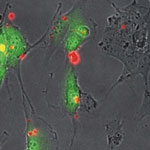 Oncogenes are genes that are associated with the development of cancer - when mutated or expressed at high levels, they can help turn a normal cell into a tumor cell. Promising new chemotherapeutic strategies have therefore focused on suppressing oncogenes. One such approach is based on RNA interference (RNAi), a technique wherein small double-stranded RNA molecules can sequence-specifically inhibit the expression of targeted oncogenes. The idea here is that with the help of small interfering RNA (siRNA), key oncogenes that modulate signaling pathways and thereby regulate the behavior of malignant tumor cells can be manipulated. To harness the full potential of this approach, the prime requirements are to deliver the siRNA molecules with high selectivity and efficiency into tumor cells and to monitor both siRNA delivery and the resulting knockdown effects at the single-cell level.
Oncogenes are genes that are associated with the development of cancer - when mutated or expressed at high levels, they can help turn a normal cell into a tumor cell. Promising new chemotherapeutic strategies have therefore focused on suppressing oncogenes. One such approach is based on RNA interference (RNAi), a technique wherein small double-stranded RNA molecules can sequence-specifically inhibit the expression of targeted oncogenes. The idea here is that with the help of small interfering RNA (siRNA), key oncogenes that modulate signaling pathways and thereby regulate the behavior of malignant tumor cells can be manipulated. To harness the full potential of this approach, the prime requirements are to deliver the siRNA molecules with high selectivity and efficiency into tumor cells and to monitor both siRNA delivery and the resulting knockdown effects at the single-cell level.
Jan 19th, 2010
 Emerging nanotechnology applications in the fields of medicine and biology often involve the use of nanoparticles for probing biological processes and structures or for constructing sophisticated nanoscale drug delivery mechanisms. Nanoparticles are already being used with dramatic success in biomedical applications. However, relatively little is known about the potential biological risks from these nanoparticle applications inside the body. The identity of nanoparticles in a biological medium, in terms of their interaction with that medium, is largely determined by the proteins that dress the particles. Since many of the toxic and therapeutic uses of nanoparticles involve the introduction of nanoparticles into the bloodstream of humans and other animals, it is particularly important to know how nanoparticles interact with blood proteins. New research performed in the Polymers Division at the National Institute of Standards and Technology (NIST) directly addresses this issue and explores the effects of nanoparticle size (5nm to 100nm) and a whole range of important blood proteins.
Emerging nanotechnology applications in the fields of medicine and biology often involve the use of nanoparticles for probing biological processes and structures or for constructing sophisticated nanoscale drug delivery mechanisms. Nanoparticles are already being used with dramatic success in biomedical applications. However, relatively little is known about the potential biological risks from these nanoparticle applications inside the body. The identity of nanoparticles in a biological medium, in terms of their interaction with that medium, is largely determined by the proteins that dress the particles. Since many of the toxic and therapeutic uses of nanoparticles involve the introduction of nanoparticles into the bloodstream of humans and other animals, it is particularly important to know how nanoparticles interact with blood proteins. New research performed in the Polymers Division at the National Institute of Standards and Technology (NIST) directly addresses this issue and explores the effects of nanoparticle size (5nm to 100nm) and a whole range of important blood proteins.
Jan 13th, 2010
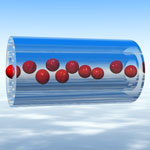 In many biomedical applications, protein nanotubes present several advantages over nanospheres. The layer-by-layer (LbL) deposition technique for the preparation of protein nanotubes has attracted considerable attention because of their potential nanotechnology applications in enzymatic nanocatalysts, bioseparation nanofilters, and targeting nanocarriers. A drawback is that in template synthesis the extraction process often results in physical deformation of the nanotubes. Researchers in Japan have now developed a new procedure using specific solvent and freeze-drying technique. They describe for the first time molecular capturing properties of protein nanotubes with a controllable affinity and size selectivity.
In many biomedical applications, protein nanotubes present several advantages over nanospheres. The layer-by-layer (LbL) deposition technique for the preparation of protein nanotubes has attracted considerable attention because of their potential nanotechnology applications in enzymatic nanocatalysts, bioseparation nanofilters, and targeting nanocarriers. A drawback is that in template synthesis the extraction process often results in physical deformation of the nanotubes. Researchers in Japan have now developed a new procedure using specific solvent and freeze-drying technique. They describe for the first time molecular capturing properties of protein nanotubes with a controllable affinity and size selectivity.
Jan 11th, 2010
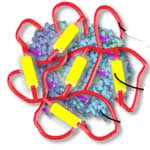 Proteins are the most important molecules inside our body. There are thousands of proteins in a single cell alone and they control our physiological reactions, metabolism, cellular information flow, defense mechanisms - pretty much everything. No wonder then that most human diseases are related to the malfunctioning of particular proteins. In contrast to gene therapy - where a gene is placed inside a cell to either replace a defective gene or to increase the amount of a specific gene in order to produce a higher amount of a desired protein - protein therapy works by directly delivering well-defined and precisely structured proteins into the cell to replace the dysfunctional protein. The problem with protein therapy, which limits its practical use in medicine, is the mode of delivery. Scientists have now demonstrated a general, effective, low-toxicity intracellular protein delivery system based on single-protein nanocapsules.
Proteins are the most important molecules inside our body. There are thousands of proteins in a single cell alone and they control our physiological reactions, metabolism, cellular information flow, defense mechanisms - pretty much everything. No wonder then that most human diseases are related to the malfunctioning of particular proteins. In contrast to gene therapy - where a gene is placed inside a cell to either replace a defective gene or to increase the amount of a specific gene in order to produce a higher amount of a desired protein - protein therapy works by directly delivering well-defined and precisely structured proteins into the cell to replace the dysfunctional protein. The problem with protein therapy, which limits its practical use in medicine, is the mode of delivery. Scientists have now demonstrated a general, effective, low-toxicity intracellular protein delivery system based on single-protein nanocapsules.
Jan 8th, 2010
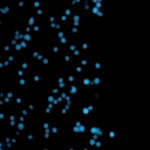 Metastasis is caused by marauding tumor cells that break off from the primary tumor site and ride in the bloodstream to set up colonies in other parts of the body. These breakaway cancer cells in the peripheral blood are known as circulating tumor cells (CTCs). Detecting and analyzing these cells can provide critical information for managing the spread of cancer and monitoring the effectiveness of therapies. Nanotechnology researchers have now developed a an efficient cell-capture platform based on 3D nanostructured substrates. The device is engineered out of nanoscale silicon pillars and has managed to capture up to 65 percent of circulating tumor cells in lab samples within human blood - far more than any existing diagnosis tool for CTC capture.
Metastasis is caused by marauding tumor cells that break off from the primary tumor site and ride in the bloodstream to set up colonies in other parts of the body. These breakaway cancer cells in the peripheral blood are known as circulating tumor cells (CTCs). Detecting and analyzing these cells can provide critical information for managing the spread of cancer and monitoring the effectiveness of therapies. Nanotechnology researchers have now developed a an efficient cell-capture platform based on 3D nanostructured substrates. The device is engineered out of nanoscale silicon pillars and has managed to capture up to 65 percent of circulating tumor cells in lab samples within human blood - far more than any existing diagnosis tool for CTC capture.
Nov 30th, 2009
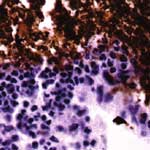 Quite a number of serious medical conditions, such as cancer, diabetes and chronic pain, require medications that cannot be taken orally, but must be dosed intermittently, on an as-needed basis, and over a long period of time. By combining magnetism with nanotechnology, researchers have now created a small implantable device that encapsulates the drug in a specially engineered membrane, embedded with magnetic iron oxide nanoparticles. The application of an external, alternating magnetic field heats the magnetic nanoparticles, causing the gels in the membrane to warm and temporarily collapse. This collapse opens up pores that allow the drug to pass through and into the body. When the magnetic field is turned off, the membranes cool and the gels re-expand, closing the pores and halting drug delivery. No implanted electronics are required.
Quite a number of serious medical conditions, such as cancer, diabetes and chronic pain, require medications that cannot be taken orally, but must be dosed intermittently, on an as-needed basis, and over a long period of time. By combining magnetism with nanotechnology, researchers have now created a small implantable device that encapsulates the drug in a specially engineered membrane, embedded with magnetic iron oxide nanoparticles. The application of an external, alternating magnetic field heats the magnetic nanoparticles, causing the gels in the membrane to warm and temporarily collapse. This collapse opens up pores that allow the drug to pass through and into the body. When the magnetic field is turned off, the membranes cool and the gels re-expand, closing the pores and halting drug delivery. No implanted electronics are required.
Nov 16th, 2009
 One of the promises of medical nanotechnology is a drug-delivery nanodevice that can image, target, and deliver drugs to a specific cancer location inside the body and monitor and if necessary adjust the drug release at the target location. Researchers in Taiwan have now designed a nanodevice that comes pretty close to this vision. They have successfully demonstrated that our multifunctional drug-delivery nanodevice - a polymer core/single-crystal iron oxide shell nanostructure bonded to a quantum dot - can image, target, and deliver drugs via remote control. The device shows outstanding release and retention characteristics via an external on/off manipulation of a high-frequency magnetic field. Furthermore, the quantum dot bonded to the nanodevice provides optical information for in situ monitoring of the drug release.
One of the promises of medical nanotechnology is a drug-delivery nanodevice that can image, target, and deliver drugs to a specific cancer location inside the body and monitor and if necessary adjust the drug release at the target location. Researchers in Taiwan have now designed a nanodevice that comes pretty close to this vision. They have successfully demonstrated that our multifunctional drug-delivery nanodevice - a polymer core/single-crystal iron oxide shell nanostructure bonded to a quantum dot - can image, target, and deliver drugs via remote control. The device shows outstanding release and retention characteristics via an external on/off manipulation of a high-frequency magnetic field. Furthermore, the quantum dot bonded to the nanodevice provides optical information for in situ monitoring of the drug release.
Nov 9th, 2009
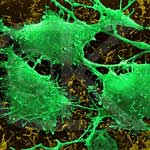 Detection at the earliest stage provides the greatest chance of survival for cancer patients. Cancer has a logarithmic growth rate and doctors typically don't see 80% of the life of a tumor. Detection can be done using a number of techniques including standard immunoassays and biopsies. Nanotechnology offers new detection approaches such as targeted contrast agents, nanoscale cantilevers coated with antibodies against tumor markers, and magnetic nanoparticles coated with DNA labeling. But the problem is daunting because there are over 50 common types of cancer and in practice it is difficult to ask people to come to the clinic on a regular basis for cancer screening. Researchers have now proposed a new method for the detection of cancer cells based on measurement of the physical adhesion of silica beads to malignant versus normal cells cultured from human cervix.
Detection at the earliest stage provides the greatest chance of survival for cancer patients. Cancer has a logarithmic growth rate and doctors typically don't see 80% of the life of a tumor. Detection can be done using a number of techniques including standard immunoassays and biopsies. Nanotechnology offers new detection approaches such as targeted contrast agents, nanoscale cantilevers coated with antibodies against tumor markers, and magnetic nanoparticles coated with DNA labeling. But the problem is daunting because there are over 50 common types of cancer and in practice it is difficult to ask people to come to the clinic on a regular basis for cancer screening. Researchers have now proposed a new method for the detection of cancer cells based on measurement of the physical adhesion of silica beads to malignant versus normal cells cultured from human cervix.
Oct 16th, 2009
 Oncogenes are genes that are associated with the development of cancer - when mutated or expressed at high levels, they can help turn a normal cell into a tumor cell. Promising new chemotherapeutic strategies have therefore focused on suppressing oncogenes. One such approach is based on RNA interference (RNAi), a technique wherein small double-stranded RNA molecules can sequence-specifically inhibit the expression of targeted oncogenes. The idea here is that with the help of small interfering RNA (siRNA), key oncogenes that modulate signaling pathways and thereby regulate the behavior of malignant tumor cells can be manipulated. To harness the full potential of this approach, the prime requirements are to deliver the siRNA molecules with high selectivity and efficiency into tumor cells and to monitor both siRNA delivery and the resulting knockdown effects at the single-cell level.
Oncogenes are genes that are associated with the development of cancer - when mutated or expressed at high levels, they can help turn a normal cell into a tumor cell. Promising new chemotherapeutic strategies have therefore focused on suppressing oncogenes. One such approach is based on RNA interference (RNAi), a technique wherein small double-stranded RNA molecules can sequence-specifically inhibit the expression of targeted oncogenes. The idea here is that with the help of small interfering RNA (siRNA), key oncogenes that modulate signaling pathways and thereby regulate the behavior of malignant tumor cells can be manipulated. To harness the full potential of this approach, the prime requirements are to deliver the siRNA molecules with high selectivity and efficiency into tumor cells and to monitor both siRNA delivery and the resulting knockdown effects at the single-cell level.
 Subscribe to our Nanotechnology Spotlight feed
Subscribe to our Nanotechnology Spotlight feed





